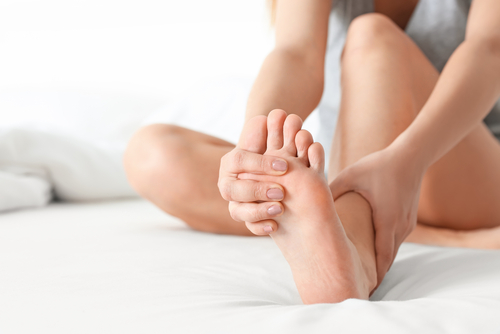You may have heard about blood clots being related to some COVID vaccine shot side effects. Don’t worry—according to the CDC, the chance of getting a blood clot from the vaccine is rare. However, if you are prone to clotting or already have a blood clot, this is a dangerous side effect you should watch out for.
Plus, blood clots can form for a multitude of other health reasons as well. Learn how to tell if you show the early signs of DVT or blood clotting. If you think you might have a blood clot, the Vein Centre surgeons are here to help in Belle Meade, Franklin, or Mt. Juliet, TN.
What is DVT Blood Clotting?
Blood clots are a natural, life-saving body function that stops bleeding after a cut or other injury. These clots are gel-like clumps of blood particles, such as platelets, fibrin, and protein strands, that work together to adhere to a blood vessel or artery and block blood flow in that area. Your body has superficial and deep vein systems, both of which could experience blood clotting.
However, if unnecessary clotting occurs, it then becomes dangerous. A potentially dangerous blood clot that forms deep in a vein is known as DVT, which stands for deep vein thrombosis. Most often, DVT occurs in a leg vein that runs through the calf and thigh muscles. When a piece of the blood clot breaks loose and flows through the bloodstream, it can become deadly.
Types of Blood Clots
When a clot forms inside deep veins and arteries, that is the beginning of a potentially serious health concern. When a clot forms blood vessels and stays in place, it is called a thrombus.
A thrombus can cut off blood flow to organs and tissue if it grows too large. Blocked blood flow can cause heart attacks, stroke, and death. If this occurs, emergency medical care is needed quickly.
Another type of dangerous blood clot is called an embolus. An embolus is a blood clot that comes loose from the vein wall. When this blood clot breaks free, it travels through the bloodstream. As it reaches smaller vessels, it can become lodged and block flow to that area. It can travel to the lungs, heart, or brain, causing pulmonary embolism and stroke.
If you are experiencing these signs of DVT below, contact your doctor immediately.
Signs of Deep Vein Thrombosis
1) Swelling in Your Legs
Swelling is possible in the exact place a blood clot has formed. In some cases, the entire extremity affected will swell up, but more commonly, the leg will is below the knee. The swelling won’t be in both your legs, only the side where there is a blood clot.
Swelling can even occur after DVT treatment. Post-thrombotic syndrome develops weeks or months after DVT and causes chronic swelling in the leg. This happens because DVT damages veins and valves, causing them to become weak. Weak veins and valves allow blood to pool in your legs resulting in pain and swelling.
Furthermore, DVT can lead to pitting edema, which is the accumulation of fluid (edema) in the limbs, typically occurring rapidly. When pressure is applied to the swollen area, it can create a temporary depression or “pit” (pitting) that remains visible for a few seconds.
2) Redness
DVT causes redness in your arms and legs because blood vessels are blocked. The red color is a result of inflammation of the vein where there are one or more blood clots and can be one of the signs of DVT. You may notice a long, thin area of redness following the affected vein.
3) Leg Pain
Blood clots cause internal pain in the veins affected. As a clot worsens, you may experience discomfort and soreness in the area. The pain can range from a dull ache to intense throbbing pain. Pain in one leg or arm and not the other is a warning sign of DVT. Discomfort often increases with walking or standing for an extended period. Many people mistake this feeling for a pulled muscle, but leg pain from DVT will not go away with time as a muscle injury does.
4) Warmth
Feeling a warm sensation is one of the first symptoms of deep vein thrombosis. Your whole body won’t feel warm, only the affected limb. Only one leg will feel warm, or you will feel warmth radiating from one limb and not the other. Sometimes, only the area right above the blocked vein will be noticeably warmer.
5) Leg Cramps
Leg cramps are a common occurrence that most of us have felt before. Regular muscle cramps will go away pretty quickly by stretching or walking. Crampy feelings in the legs that won’t go away or worsen over time are symptoms of DVT. Cramping caused by DVT needs medical attention before it becomes dangerous. One test to see if you are experiencing a normal leg cramp or one from deep vein thrombosis is to bend the foot at the ankle so that your toes are pointing upward. With a normal cramp, this should alleviate pain. In the case of a blood clot, the pain will most likely intensify.
Leg pain can be an early sign of DVT – Contact the Vein Center in Tennessee

6) Skin Discoloration
Besides just turning limbs red, DVT can cause problematic skin discoloration and symptoms. Blood clots create high-pressure areas where veins are blocked. As blood cells try and pass through the high-pressure area, the cells are often damaged and proceed to break down. Hyperpigmentation occurs, and your skin can become dry, flaky, or itchy. Advanced cases of DVT without treatment are likely to develop eczema and skin ulcers in the affected area.
Changes in Varicose Veins
Those who have varicose veins may be at higher risk of DVT. In addition to the above symptoms, if you have varicose veins, look out for these signs of DVT:
- Bulging Veins: A vein that protrudes and does not flatten when the leg is elevated or laid flat, possibly indicating a superficial or minor blood clot within the varicose vein.
- Hardened Veins: A vein that hardens suddenly can be DVT.
- Tender and Red Skin: Skin surrounding a varicose vein that becomes sensitive and reddened.
If you experience any of these symptoms, plus:
- Chest Pain
- Shortness of Breath
- Coughing up Blood
Immediately seek medical attention. DVT and its complications can be serious and even life-threatening.
How Do I Know If It’s a Leg Cramp or Blood Clot?
The pain may resemble a severe muscle cramp or a charley horse. When dealing with a blood clot, elevating or applying ice to the leg typically doesn’t alleviate swelling. If elevating the leg or using cold compresses does reduce the swelling, it’s more likely a muscle injury.
As a blood clot progresses, the affected leg may feel warm. You might even see a subtle reddish or bluish tint to the skin, which can appear as a darker brown or discolored area on individuals with darker skin tones.
There’s generally no cause for concern about a clot if the leg pain worsens during exercise but eases with rest.
Key Points to Remember
- Both leg cramps and blood clots in the leg can result in calf muscle pain.
- Certain symptoms, like leg warmth and discoloration, can help distinguish between cramps and blood clots.
- Leg cramps typically resolve without medical treatment and pose no significant harm, whereas a leg blood clot can be more severe and require medication to prevent complications.
When to Seek Medical Attention for Leg Cramps
Although these distinctions can aid in identifying leg cramps versus DVT, it’s advisable to consult a healthcare provider for assistance, as you cannot self-diagnose. Here are additional reasons to seek professional help:
- If your symptoms are severe or significantly disrupt your daily life.
- If you develop new leg swelling, redness, or warmth that wasn’t present previously.
- If you have risk factors for DVTs or blood clots.
When you visit the doctor, your provider may conduct blood tests or order a vein ultrasound if they suspect DVT.
What Causes DVT?
Many risk factors that can contribute to DVT. Though, some factors are controllable, and it’s possible to reduce your risk through healthy lifestyle changes and proper medical treatment. Here are some risk factors for DVT:
DVT Risk Factors
- Prolonged Immobility: Sitting or lying in one position for long periods, such as during long flights or bed rest after surgery, can slow blood flow and increase the risk of clot formation.
- Surgery and Trauma: Surgeries, particularly orthopedic surgeries like joint replacement, can increase the risk of DVT. Trauma or injury to the veins can also trigger clot formation.
- Medical Conditions: Certain medical conditions and diseases, such as cancer, heart disease, and inflammatory disorders, can increase the risk of DVT.
- Genetic Factors: Some people have an inherited tendency to develop blood clots due to genetic mutations in clotting factors.
- Hormonal Changes: Hormonal changes, such as those associated with pregnancy, birth control pills, and hormone replacement therapy, can increase the risk of DVT.
- Obesity: Being overweight or obese can contribute to DVT risk due to increased pressure on the veins.
- Smoking: Smoking damages blood vessels and increases the risk of clot formation.
- Age: The risk of DVT
Contact a Vein Doctor
If you are experiencing leg swelling, skin discoloration, redness, cramping, warmth, and pain, you may have DVT. Give the Vein Centre in Tennessee a call at 615.269.9007. Please schedule an appointment with our board-certified vascular surgeons in Belle Meade (Nashville), Franklin (Cool Springs/Brentwood), and Mt. Juliet, TN, as soon as possible. Blood clots are dangerous, and it is better to err on the side of caution if you are experiencing signs of DVT.



